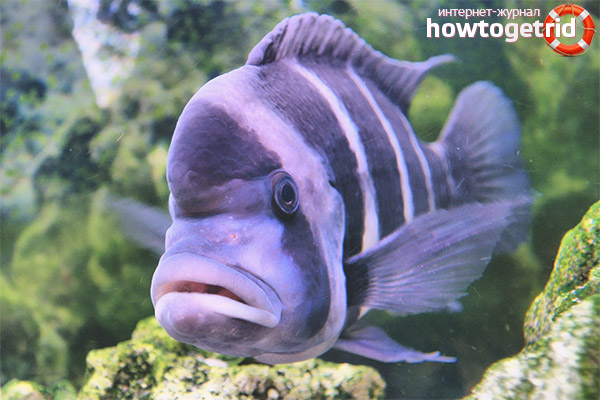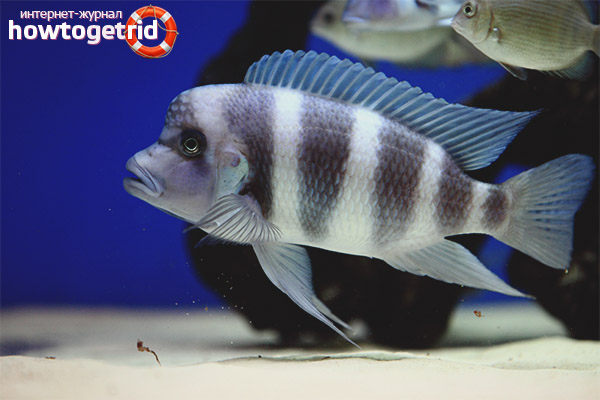The content of the article
In Latin, frontosis is referred to as Cyphotilapia frontosa. The fish is very beautiful and is very popular among those who are not indifferent to cichlids. Even in an aquarium, it is distinguished by its pronounced attractiveness due to its large size and bright color. They are always visible due to their colorful colors. The size of the fish is really impressive, because in length it can reach 35 cm. The color of the fish is really interesting. The blue and white background is marked by the presence of black stripes on the body.
The frontal phytotherapy is not difficult to care for, but it requires a fairly spacious aquarium equipped with modern high-quality equipment. To get this fish is better for those who already have enough experience in this matter. These fish are not marked by significant aggression, therefore their content with various other types of fish is allowed.It is better to keep them in separate groups, the place of which will be a large aquarium. The group usually consists of one male and three females. Very well, if individuals will be present in the amount of 8-12 pieces. It is not difficult to guess that in this case a rather capacious aquarium will be required.
If one fish is contained, then it will require a volume of 300 liters of water. Some fish need at least 500 liters. Ideally, the bottom should be sandy with the presence of stones. Plants are not required, although some of them can still be planted.
Frontosis is characterized by the property of good livability with its neighbors. But this is observed only until the moment when someone has not encroached on its territory. Therefore, if the aquarium is small, there is no point in keeping it in it. Do not contain it together with those fish that Frontoza can swallow. If the opportunity presents itself to her, she will definitely take advantage of it. In this you can be absolutely sure.
Being in nature
In the diet uses fish, mollusks, various invertebrate representatives. The fish has a large and strong body with a large head on it with a pronounced forehead. In terms of aquarium content, body length can reach three dozen centimeters. Females differ somewhat more modest dimensions. Of course, in the wild, all parameters parameters have more significant values. You can find an individual whose length reaches 40 centimeters. On average, representatives of this species can live for 20 years.
In males, pronounced fatty growth in the forehead. But at a young age he is absent. Body color is gray-blue shades. The body has six black stripes.The color of the fins is different, from white to blue. The shape of the fins is elongated and pointed in nature.
Conditions of detention

Frontosis requires clean water for maintenance, and prefers to swim in a spacious aquarium. Requires regular water changes. Necessary and proper selection of neighbors. Of all known cichlids, frontose is the most tranquil species. Large fish can easily be its neighbors, but this is highly undesirable because they can simply eat it.
Feeding pattern
The food consists of various live foods. Under natural conditions, it feeds on various small fish and various mollusks. When the aquarium content for food suitable fish, worms, shrimp, small pieces of squid carcass. Allowed for cooking self-made minced meat. Also, the fish can be fed with bloodworms, pipemakers, Artemia. With a deficiency of vitamins spend the use of various additives. A good example is spirulina. Feeding is carried out several times a day. At one time there is a small portion of feed.
Aquarium conditions
This view is extremely leisurely. It can float throughout the artificial reservoir and requires large volumes of water. If there is only one frontose, then an aquarium of at least 300 liters is needed. Of course, it is better if there are at least four individuals, but in this case the minimum volume of the aquarium should be 500 liters.
Conduct regular replacement of water, as well as install a powerful external filter. This is due to the increased sensitivity of cichlids to purity. Such an installation will allow not only filtering, but also enhance gas exchange and oxygen saturation of water. In nature, cichlids require water with good oxygen saturation. Never interfere with activities aimed at additional aeration. Constant monitoring of the qualitative composition of water is required.
Important! You can not overfeed the fish and densely colonize the aquarium.
Requires stable water parameters. It is important to monitor the large amount of oxygen dissolved in it. The ideal temperature is around 24-26 degrees. Natural water is hard, has a pH shift in the acidic side.If the water in the area of residence is soft, this can create additional difficulties. In this case, more hard water is made artificially. For example, carry out the addition of coral chips.
If you create optimal conditions for keeping and bring the water closer to the required parameters, then with the survival of the fish, as a rule, there are no problems. Care should be taken to avoid a sudden change of water parameters. Therefore, it is necessary to add it in small portions.
The question of plants does not require a serious approach. They are not as important for these fish as the condition and character of the bottom. It is better if the bottom will be sandy in nature. It is good if some shelters are built in the form of large stones and coats. This is due to the fact that the frontose is somewhat timid and does not mind hiding somewhere. Stones should stand firmly and not fall during the shelter of fish in them.
Neighborhood with various types of fish

In general, the fish is not aggressive. However, she loves territoriality. The ideal option would be their separate content.It should always be remembered that this species is a predator, and is able to eat other representatives that it can simply swallow. A flock with content must consist of at least one male and three females.
By gender, it is quite difficult to distinguish between fish, although males are somewhat larger than females.
Breeding principles
For spawning requires a large aquarium of at least 400 liters. The water temperature should be 25-28 degrees, and pH - 8 units. The female is able to lay up to 50 large eggs. Place is prepared by the male. It is usually located between the stones. After laying eggs, they are fertilized by the male.For three days, the fertilized eggs of the female are hatched in the mouth. Then the fry begin to hatch. Incubation of the fry also takes place in the female’s mouth. At this time, the territory is carefully guarded by a male. Care of fry will last for 4-6 weeks. They are fed with artemia.
Video: frontose aquarium fish











To send